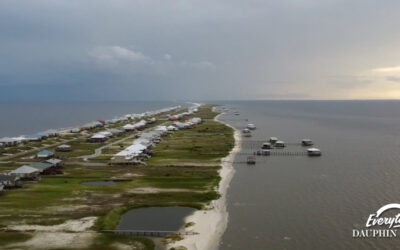A Testament to History
Nestled on the beautiful Dauphin Island, Alabama, Fort Gaines stands as a testament to American history. With its storied past, spanning over 150 years, this significant landmark invites visitors to delve into its fascinating history, while also offering breathtaking views of the Gulf of Mexico. This article will take you on a historical journey through the inception, construction, and major events that shaped Fort Gaines into the well-preserved gem it is today.
Establishing the Fort: The Early Years
Fort Gaines was established during a time of heightened tensions in the United States. With the nation on the brink of the Mexican-American War, it was deemed necessary to fortify the Gulf Coast. Construction began in 1821 under the guidance of General Edmund Pendleton Gaines, for whom the fort was named.
Design and Construction
Inspired by French engineer Sebastien Le Prestre de Vauban’s designs, Fort Gaines was initially envisioned as a formidable fortress to protect the vital shipping channel of Mobile Bay. The design featured five bastions, each serving a different purpose, with high walls and a dry moat surrounding the fort.
The construction process was labor-intensive, requiring the use of brick and concrete to build the fortress. However, due to delays caused by yellow fever outbreaks and funding issues, construction was not completed until 1862, more than 40 years after its inception.
A Key Player in the Civil War
The location of Fort Gaines made it a vital military asset during the Civil War. Both the Union and the Confederate armies recognized its strategic importance and sought to control it. The fort’s history during the war can be divided into three main stages: Confederate occupation, the Battle of Mobile Bay, and Union control.
Confederate Occupation
As the Civil War began in 1861, Confederate forces took control of Fort Gaines, recognizing its importance in defending Mobile Bay. They completed the remaining construction work and added further fortifications. During this time, the fort housed a garrison of approximately 600 men, who prepared for the inevitable Union assault.
Battle of Mobile Bay
The Battle of Mobile Bay, fought in August 1864, was a turning point in the Civil War. It marked the beginning of the end for the Confederacy. Admiral David Farragut led a fleet of 18 Union ships against a combined force of Confederate vessels and the guns of Fort Gaines and nearby Fort Morgan.
During the battle, Farragut famously ordered his fleet to advance, despite the danger of underwater mines, with his legendary command, “Damn the torpedoes, full speed ahead!” After a fierce naval battle and subsequent bombardment, Fort Gaines was forced to surrender to Union forces.
Union Control
Following the Confederate surrender, Fort Gaines remained under Union control for the rest of the Civil War. The Union Army used the fort as a prison for Confederate prisoners and a base for operations in the region. This period marked the end of Fort Gaines’ active involvement in the Civil War.
Fort Gaines After the Civil War
Although Fort Gaines’ military importance waned after the Civil War, it continued to play a role in American history, particularly during times of conflict.
Spanish-American War
During the Spanish-American War of 1898, Fort Gaines was revitalized as a coastal defense. Although the fort didn’t witness any direct combat during the conflict, it was home to several companies of artillery, who remained on guard for potential enemy incursions.
World War I and World War II
Throughout World War I and World War II, Fort Gaines served as a training ground for the U.S. military. Soldiers were stationed at the fort to learn essential skills such as signaling, coast artillery, and anti-aircraft gunnery. Despite its lack of direct involvement in combat during these conflicts, the fort played an essential role in the development and training of military personnel.
Fort Gaines Today: A Historic Gem
After World War II, Fort Gaines was decommissioned, and ownership was transferred to the Alabama Marine Resources Division. In 1974, the Dauphin Island Park and Beach Board assumed responsibility for the site, working tirelessly to preserve and restore the historic fort.
Today, Fort Gaines is a popular tourist destination, where visitors can explore the restored fortifications, barracks, and museum displays. The site hosts numerous events throughout the year, including historical reenactments and living history programs, to bring the past to life for visitors of all ages.
Don’t Miss the Dauphin Island Historical Forts Tour
To make the most of your visit to Fort Gaines, consider taking the Dauphin Island Historical Forts Tour. This immersive experience will take you on a guided journey through the island’s fascinating history, including visits to both Fort Gaines and its sister fort, Fort Morgan. Learn about the role these forts played in shaping American history, and discover the strategic importance of Dauphin Island.
Fort Gaines is an invaluable piece of American history, offering visitors the opportunity to delve into its storied past while enjoying stunning views of the Gulf of Mexico. As you explore the island, be sure to add this historic treasure to your must-visit list, and immerse yourself in the fascinating events that have shaped the fort’s history.
In the future, EverythingDauphinIsland.com may expand its offerings with articles exploring other historical landmarks and events that took place on the island. Be sure to keep an eye out for updates and new content that will further enrich your knowledge and experience of Dauphin Island’s rich past.
Getting to Fort Gaines
Reaching Fort Gaines once you’ve made your way onto Dauphin Island via Alabama’s Coastal Connection (Highway 193) is a journey that’s as straightforward as it is scenic. Fort Gaines, known for its historical significance and picturesque location on the eastern tip of Dauphin Island, offers visitors a unique glimpse into the past amidst the beauty of the Gulf Coast. Here’s how to find your way to this historical landmark after arriving on the island.
Directions to Fort Gaines from Highway 193
- Cross the Dauphin Island Bridge: Your adventure to Fort Gaines begins as you cross the high-rise Dauphin Island Bridge, offering panoramic views of the bay and the Gulf of Mexico. This bridge serves as the gateway to Dauphin Island, welcoming you to its rich history and natural beauty.
- Follow Bienville Blvd: After crossing the bridge, you’ll be on Bienville Blvd, the main road that traverses the length of Dauphin Island. Continue straight on Bienville Blvd as you head towards the eastern end of the island.
- Drive Through the Island: As you drive along Bienville Blvd, you’ll pass by the island’s central hub, featuring local shops, eateries, and the public beach. The road will take you past the residential areas and into the more natural landscapes that characterize the eastern portion of Dauphin Island.
- Approach Fort Gaines: Keep driving east on Bienville Blvd. The road will lead you directly to Fort Gaines, located at the very end of the island. You’ll notice the landscape becoming more historical and natural as you approach the fort.
- Arrival at Fort Gaines: Fort Gaines is situated on the right side of the road, just before the entrance to the Dauphin Island East End Public Beach. Look for the signs indicating the entrance to the fort. There is a parking area available for visitors to the fort.
- Explore Fort Gaines: After parking, make your way to the entrance of Fort Gaines. Here, you can purchase tickets and begin your exploration of this historic fort, enjoying the exhibits, the views of the Gulf, and the fort’s well-preserved architecture.
Tips for Your Visit to Fort Gaines
- Check Operating Hours: Fort Gaines has specific operating hours, which can vary by season. Check the latest schedule before your visit to ensure you have plenty of time to explore.
- Wear Comfortable Shoes: The fort and its surroundings offer much to explore, so wear comfortable shoes suitable for walking on uneven surfaces.
- Bring Water and Snacks: Especially during the warmer months, it’s a good idea to bring water and perhaps some snacks, as options may be limited on-site.
- Prepare for the Weather: The Gulf Coast can be hot and sunny, so sunscreen, hats, and protective clothing are recommended. Also, be prepared for sudden changes in weather.
By following these directions and tips, your visit to Fort Gaines will not only be a journey through the natural beauty of Dauphin Island but also a step back in time to explore an important piece of American history. Enjoy your adventure to this historic landmark!



